Vegan kimchi that’s as good as the traditional version! It tastes nice and clean!
It’s fall – kimchi making season! Napa cabbages are simply beautiful and sweet this time of year. Let’s make some kimchi! This time, vegan kimchi that’s as good as the traditional version!
I’ve already shown you how to make traditional kimchi, mak kimchi, and white kimchi. These kimchi recipes include fish sauce (myulchiaekjeot) and salted shrimp (saewujeot), so I’ve been getting a lot of questions about substitutes for these ingredients. Here’s my answer – vegan kimchi!
What’s vegan kimchi
While salted and fermented seafood condiments (jeotgal) are essential ingredients for most kimchi types, vegan kimchi is not a strange concept in Korea. Buddhist temple food is 100 percent plant based, and kimchi is no exception!
In place of salted and fermented seafood, which is the source of the deep savory taste of kimchi, temple cooks use soup soy sauce (gukganjang, 국간장) or sometimes fermented soybean paste (doenjang, 된장), along with dashima (다시마, dried kelp) or vegetable broth. For natural sweetness, they commonly add fruits and vegetables such as Korean pear, apple, persimmon, pumpkin, etc.
This vegan kimchi recipe is inspired by temple kimchi, but it’s definitely NOT temple kimchi. There are five forbidden vegetables in temple cooking, and garlic and scallions are two of them. Well, I used them in this recipe.
I like the temple idea of pumpkin in fall kimchi. I steamed and pureed it, but you can use canned pumpkin puree if you want. Any deep orange flesh pumpkin works.
One of the common vegetables in traditional fall/winter kimchi is gat, 갓, (mustard green). Its aroma is prominent in kimchi in a nice way. Korean mustard green is not always available around here, so I tried regular mustard green that you can find at some of your local groceries or any Asian markets. It’s pretty close! Consider it optional, but I strongly recommend you use it!
I really liked how this vegan kimchi turned out. It tastes nice and clean! Even if you’re not vegan, I think you will love this kimchi!
For more Korean cooking inspirations, follow along on YouTube, Pinterest, Twitter, Facebook, and Instagram.
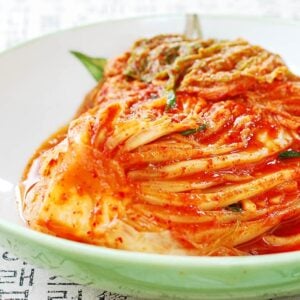
Ingredients
- 1 large napa cabbage about 5 pounds
- 1 cup Korean coarse sea salt for making kimchi much less (reduce by 1/4 or 1/3 depending on your salt)
- 3/4 pound Korean radish mu (무)
- 3 stalks scallions
- 3 large mustard green, gat (갓), leaves - optional Korean red mustard green or regular mustard green you can find in your local grocery
Seasonings
- 1/2 cup Korean red chili pepper flakes gochugaru (add a couple more tablespoons if you like)
- 1/2 apple or Korean pear grated (or blended with garlic and ginger below)
- 2 tablespoons minced garlic add one more tablespoon if you like
- 1 teaspoon grated ginger
- 1/2 cup pumpkin puree (canned) - optional see note
- 2 tablespoons soup soy sauce (gukganjang, 국간장) or more salt
- 2 tablespoons salt or to taste (start with 1 and gradually add after tasting
- 1 cup dashima broth dried kelp broth (Boil 1 large piece of dasima in 2 cups of water for 10 minutes. You can add one or two dried shiitake if available.)
- 1 tablespoon glutinous rice (you can also use 3 TBS cooked rice, blended with apple or Korean pear noted above) sweet rice powder (Mix it with 1 cup daima broth, simmer over low heat until it thickens to a thin paste and cool.
Kitchen tools
- a large bowl or pot 7 - 8 quarts
- a large colander
- kitchen gloves
- a 3/4 - 1 gallon airtight container or jar
Instructions
- Cut the stem end of cabbage lengthwise in half only about 3 - 4 inches in. Then, slowly pull apart to separate into two pieces by hand. Do the same for each half to make quarters. Running the knife through all the way would unnecessarily cut off the cabbage leaves.
- In a large bowl, dissolve 1/2 cup of coarse sea salt in 5 cups of water. Thoroughly bathe each cabbage quarter in the saltwater one at a time.
- Using the other half cup of salt and starting from the outermost leaf, generously sprinkle salt over the thick white part of each leaf. Repeat with the rest of the cabbage quarters. Try to salt all the cabbage quarters with the 1/2 cup salt, but you can use a little more if needed. Set aside for about 6 - 8 hours, rotating the bottom ones to the top halfway through.
- Meanwhile, make the glutinous rice paste and the broth and cool. Prepare the other seasoning ingredients. Mix all the seasoning ingredients. Set aside while preparing the other ingredients until the red pepper flakes become pasty.
- The cabbages should be ready to be washed when the white parts are bendable with a bit of resistance. Rinse thoroughly 3 times, especially between the white parts.
- Drain well, cut side down.
- Cut the radish into matchsticks (you can use a mandoline if available). Roughly chop the scallions and the optional mustard green. Transfer to a large bowl.
- Combine with the seasoning mix. Mix well by hand. Taste a little bit. It should be a little too salty to eat as is. Let it sit for 30 minutes to an hour to allow the flavors to meld nicely.
- Cut off the tough stem part from each cabbage quarter, leaving enough to hold the leaves together. Place one cabbage quarter in the bowl with the radish mix. Spread the radish mix over each leaf, one to two tablespoons for large leaves. Eyeball the stuffing into 4 parts and use one part for each cabbage quarter.
- Fold the leaf part of the cabbage over toward the stem and nicely wrap with the outermost leaf before placing it, cut side up, in a jar or airtight container. Repeat with the remaining cabbages. Once all the cabbages are in the jar or airtight container, press down hard to remove air pockets. Rinse the bowl that contained the radish mix with 1/4 cup of broth (if any remaining) or water and pour over the kimchi.
- Leave it out at room temperature for a full day or two, depending on how fast you want your kimchi to ripe. Then, store in the fridge. Although you can start eating it any time, kimchi needs about two weeks in the fridge to fully develop the flavors. It maintains great flavor and texture for several weeks.


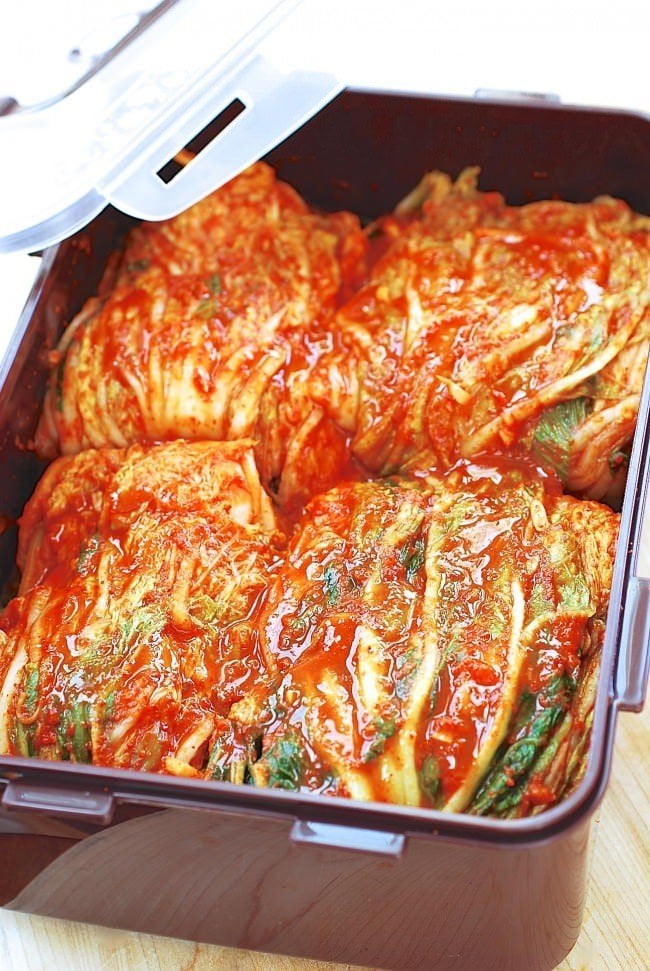
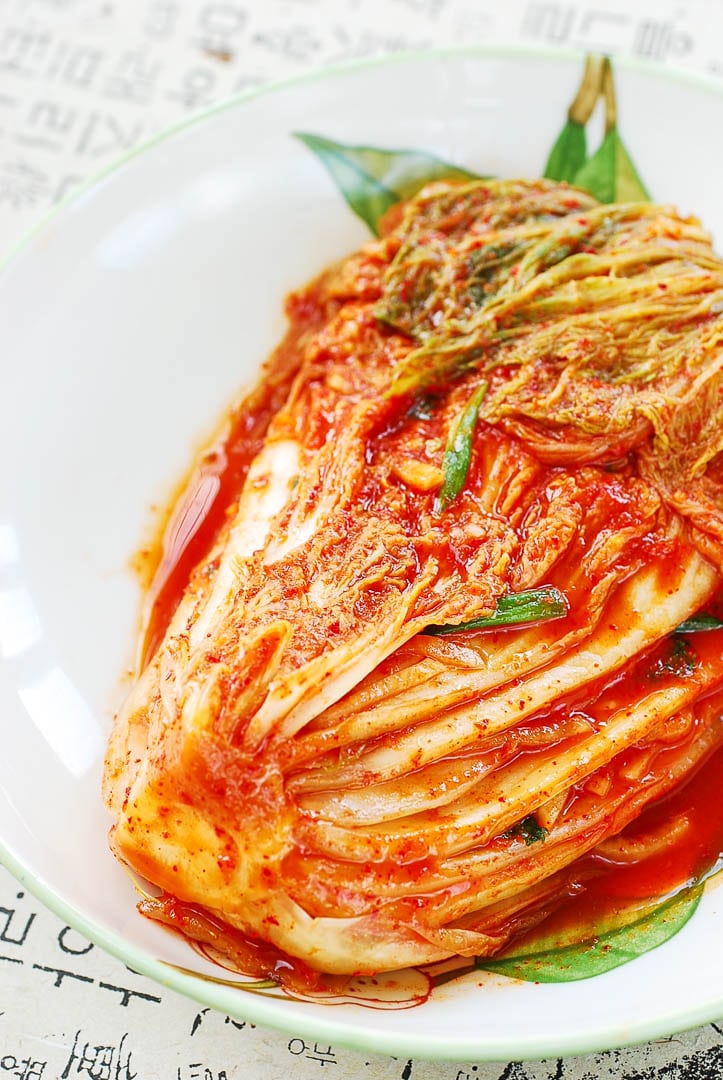
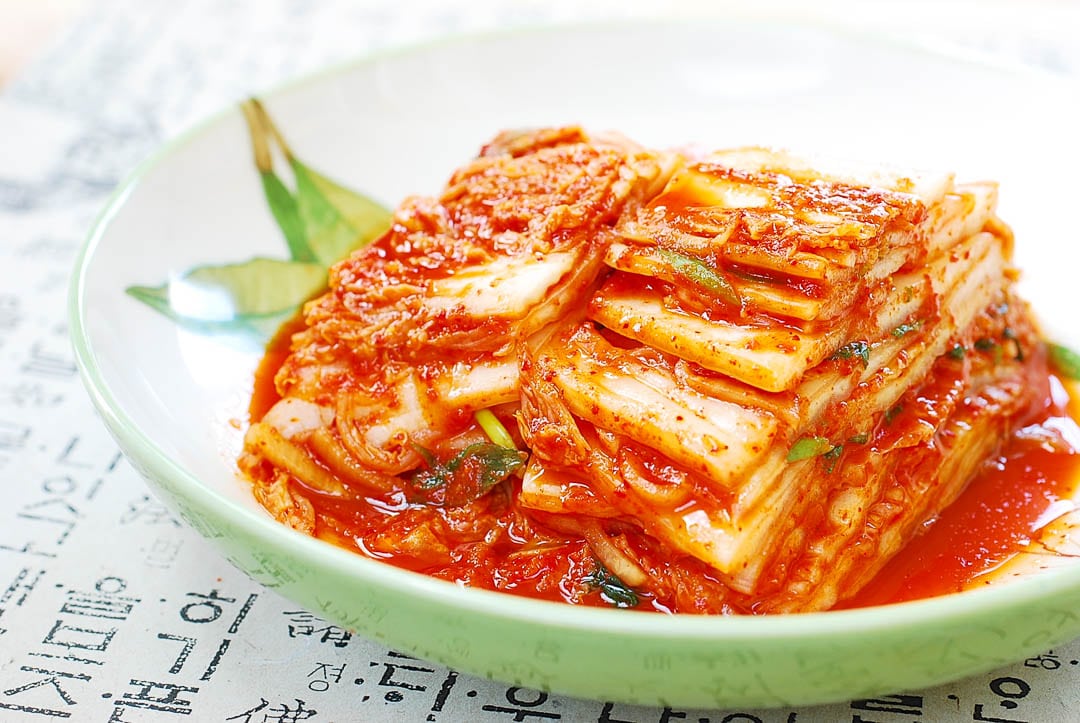
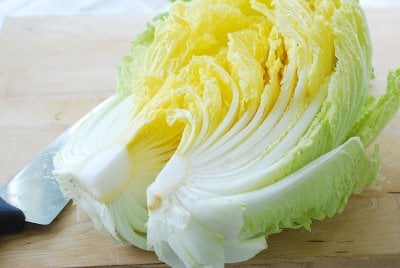
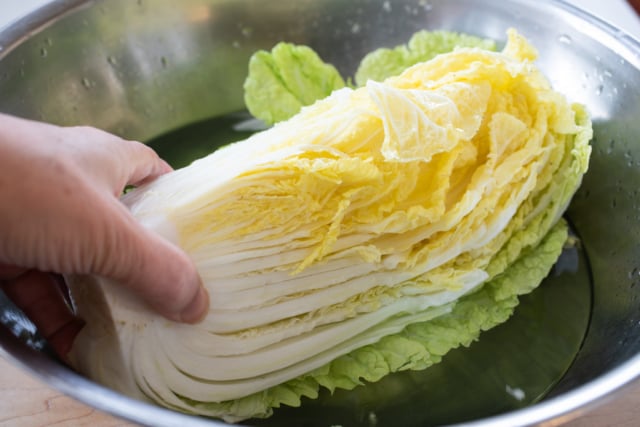
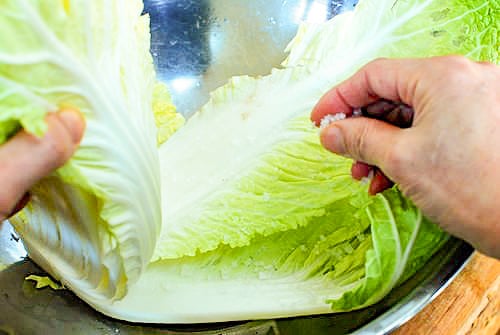
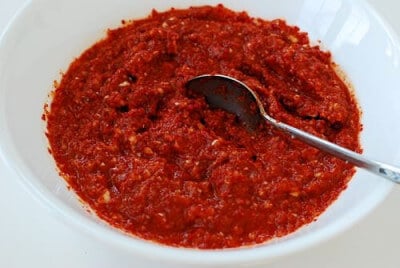
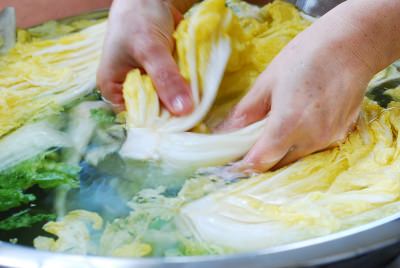
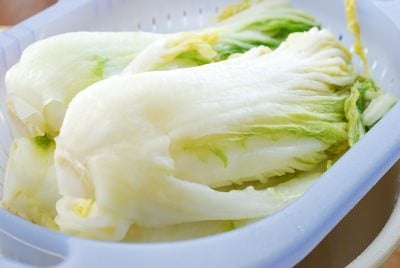
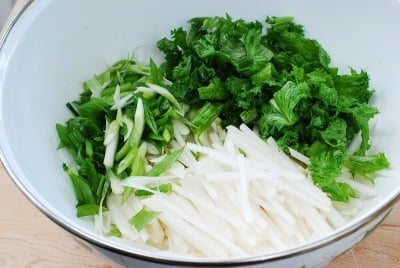
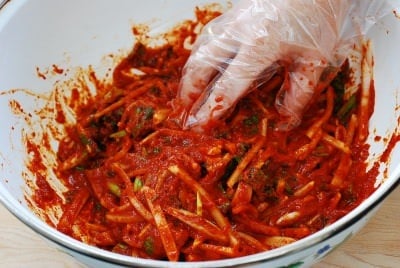
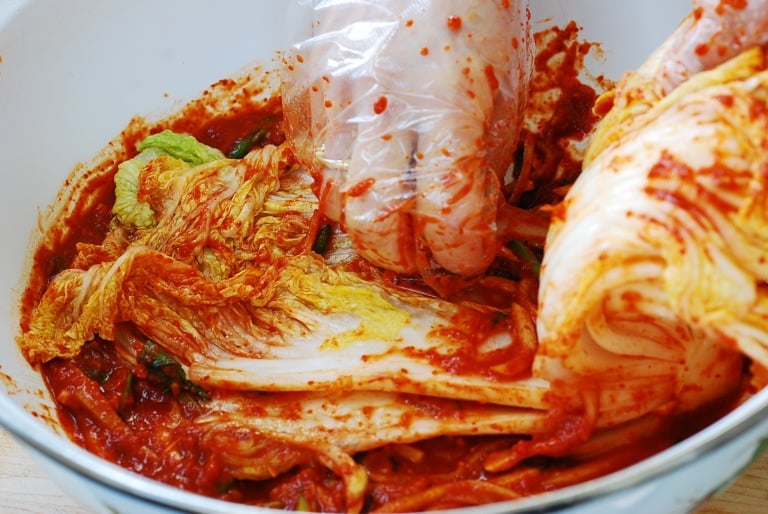
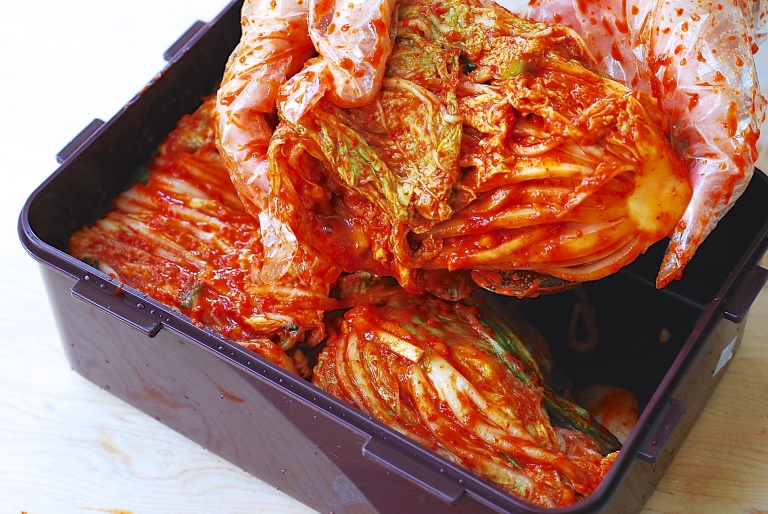

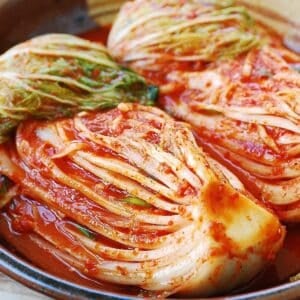
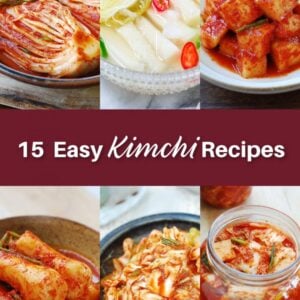
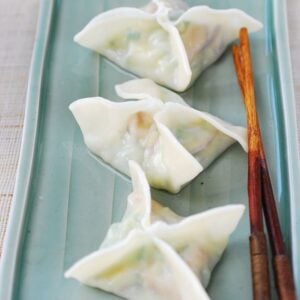













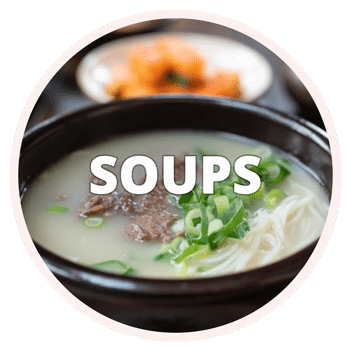



Anna says
Thank you so much for the recipe. I make it often at home. Kimchi became part of my life.
Rinku says
I loved this recipe. 2 questions if you can help… First I have gochugaru paste and not flake. Will the taste change if I use the paste? Can I use this? If yes, Will quantity be same?
Second, I have dark soy sauce. I have not seen soup soy sauce in India. Can I use this? If yes, Will quantity be same?
Hyosun says
Gochujang (Korean fermented red pepper paste) is not typically used to make kimchi. It’s fermented and includes various other ingredients than gochugaru, so it will taste different. It’s clearly not a substitute for gochugaru in this recipe. Dark soy sauce also is not typically used in kimchi, but you can use a little bit instead of soup soy sauce.
Maciej says
I have a question reading the broth. It says 1 cup but the recipe only mentions 1/4 cup of the broth being used. What happens to the rest of it?
Hyosun says
I see where the confusion is. 1 cup is used in the seasoning paste and extra liquid is from the remaining broth. It can be water if there’s no remaining broth. I’ve revised the recipe to clarify it. Thanks!
Carolina says
hello Hyosun!
I’ve just made your recipe and I am really looking forward on trying it out!
Do I leave the jar open or airtight closed?
Many thanks, Carolina.
Hyosun says
Always closed!
James says
I’ve made this recipe so many times, and my family can’t tell the difference between this kimchi and the non vegan kind. Thanks!
Laury says
Thank you so much for this article! I have been making kimchi for years, but this time I used added leeks and fermented soybean paste. Because the soybean paste made a darker heavier liquid, I was having second thoughts and wondered if I had ruined my kimchi. I also use mostly bok choy with only 1 head of napa cabbage.
I was so happy to see your mention of soybean paste! whew!
Hyosun says
That was very creative of you. Try to use less if kimchi was too dark.
patricia joanides says
Hi Hyosun,
This Vegan recipe sounds delish. My question, do you or can we use a regular 1-2 quart Mason Jar to ferment your Kimchi? If so, do you recommend using weights to hold veggies under the brine? i noticed that you used what looked like a covered casserole dish. Is this what you recommend to use to put the prepared Kimchi in for it to ripen? Thanks for any advise on this. This looks fabulous and it will be my first time making Korean Kimchi.
Hyosun says
Hi Patricia! You can use a mason jar, the larger the better. This type of kimchi doesn’t produce enough liquid for it to be submerged in. A casserole dish in my vegan kimchi post?
patricia joanides says
Hi Hyosun,
thanks for your reply. Would this, “Fermentation Crock Jar Sauerkraut Crock – Kimchi and Pickle, 2 Liter (0.5 Gallon) Ceramic Pickling Crock with Lids & Weights, Sauerkraut Fermenter Container Water Seal Fermenting Crock Jar, on Amazon, be a good choice for Fermenting your recipe?
If there is not enough liquid to submerge the Kimchi, how does it ferment?
Sorry, i’m a bit confused how it works, maybe not like normal ferments?
Thank you,
patricia
Karina says
Thank you so much for this vegan recipe! I want to try it as soon as I have some free time to spend in the kitchen. One question: I don’t like pumpkin and rarely eat it, and I plan on skipping the pumpkin puree. For the volume of liquids to be proportional, would you recommend adding an extra 1/2 cup of water?
Hyosun says
Yes Katrina. That’s fine, or dashima broth if using. You can also use more grated pear (or apple).
Alex says
Out of curiosity: can the extra salt and soy sauce be omitted? Or are they there to aid fermentation?
I’m trying to lessen my sodium intake and as I enjoy eating kimchi daily, I’ve been trying to find a recipe where there is not (much) added salt – other than for salting the cabbage. However, I obviously will not experiment with leaving it out if it is part of what makes the kimchi ferment and shelf stable!
Hyosun says
You can certainly reduce the salt level, but it needs some salt for fermentation and storage. When you salt the cabbage, you wash off most of the salt, so you are not consuming all that salt. Because the vegan kimchi doesn’t use salted and fermented seafood, soy sauce is used to give a bit of flavor.
Magdalena says
Forgot to ask you…what is the purpose of the pumpkin puree? Thanks 🙂
Magdalena says
Thanks for a great recipe to make kimchi at home which I’ve done twice using your recipe! I’ve been trying other recipes of yours and they turned out great and def authentic 🙂
Chong Pit Choo says
Hello Madam. My kimchi is a bit too spicy. I ve made it a week ago. Can I add in raddish, carrot & spring onion now? Will it be better or will it get spoilt ?
Hyosun says
Has it been in the fridge? Cut up some radish and salt them before adding. Another thing you can do is to add some salt water to dilute the seasoning, similar to mul kimchi with less liquid. One of these works better if the kimchi is not too ripe. But, try it any way.
Rebecca says
I made this in January and making it again this weekend (thanks to extra Napa cabbages in my farmbox). Thank you for such clear, detailed instructions! It came out soooo good last time, I’m really excited to have more.
Amanda says
Hello, I’m just getting ready to make this very soon. With store bought kimchi, it comes out in manageable chunks. When is the best time to make that happen with homemade?
zeba durrani says
Thank you, Thank you for all your Kimchi recipes and the step by step guides. With your help I made my first batch of Kimchi yesterday and it was absolutely amazing.
Jesse-Gabriel says
Ich liebe veganes Kimchi, ich könnte es den ganzen Tag essen.
Dein Blog ist Großartig danke für die ganzen genialen Rezepte.
Viele Grüße,
Jesse-Gabriel aus Berlin
Anja says
Oh thank you, I loooove vegan kimchi! I always have to be careful with any sort of fish or seafood products (allergies ahoi!), so it’s awesome that I can make kimchi now, without thinking about wether or not I’m going to suffer after eating it. ❤️
Hyosun says
Great! Hope you get to make it soon!
Barbora says
OMG, this is so amazing. I was living in Korea for 2 and half years and back to Europe I miss Kimchi a lot. In the Asian store I can buy just very small packages and they are also very expensive. As I am vegan it is even more hard to find a vegan one. I will definitely try this recipe. Thanks a lot for posting this!
Caitlyn Yong says
Hi,
I would like to ask if the same recipe could be use for Kkakdugi as well? I am thinking of making one batch of kimchi as well as Kkakdugi over the weekend.
Thank you!
Glorina says
I love it so yummy, thanks for sharing vegan kimchi, please continue to share your knowledge.
Holly J says
I made this recipe and substituted the fruit for a 1/4 c pineapple juice and it seemed to work well. The only problem I had is I used Vietnamese pepper flakes and my kimchi is SO hot I cannot eat it! Are Korean pepper flakes milder in comparison? I could not find them at the Vietnamese market I went to. Would it have the same flavor profile if I used half the amount of what you called for for pepper flakes? Or do you have a milder substitute you recommend?
Hyosun says
Reducing the amount might help, but unfortunately, you will need Korean pepper flakes for kimchi if you want the same flavor profile. Not sure where you live, but have you tried to find it on-line?
Angela Kahl says
So I made this recipe, and left it to ferment for a couple of days. It tasted delicious, but nothing like what I’m used to from storebought kimchi. I figured that I did something wrong, and took some of it to my Korean language class. I knew that somewhere in that army of Korean Mums, there had to be someone who knew what I’d done wrong.
The verdict: I put too much water in it (I thought I might have made too much kelp broth.), and should have fermented it in the fridge rather than my counter (I’d always fermented kimchi on my counter in Illinois.). But other than that, they said that the flavor difference I was concerned about just meant that it was homemade, not storebought.
Also, my Korean class kind of descended on what I brought. I took no kimchi home. But they loved the idea of sweetening it with pears, and of using kelp. So… this was a huge hit in Changwon’s Korean language class. 😀 And I have vegan kimchi to eat now!!!! YAY!
Jijo says
Apologies just got the recipe, seems delicious.
Love your website 🙂
do you think vegan kimchi have the same benefits?
thank you
Hyosun says
Thank you! Yes — lots of benefits of kimchi come from the cabbage itself and fermentation. Hope you make it soon.
Jijo says
Hello,
I am very excited to try a Vegan Kimchi, and i love the way you explain the ingredients and recipes. but apologies, where is the recipe for the vegan option? what did you substitute the fermented fish with?
Thank you
Marti Hand says
Thank you, thank you, thank you for this vegan kimchi recipe. I’ve been vegan for a few years now…will definitely try out your recipe!
Hyosun says
You’re welcome! We are eating two batches I made for this post. It’s so good! Enjoy!
J. says
Thank you for posting a vegan-friendly kimchi recipe! I’ve been vegan for years and I always really appreciate it when people veganize their recipes for people like me. <3
Hyosun says
You’re welcome! I hope you get to make it soon and enjoy.
kate says
wow, so happy you made a vegan kimchi recipe, i’m gonna try it out as soon as possible. maybe you can do a white vegan kimchi aswell in the future. 😀
i really love vegan food and always happy when i find a nice subsitution for the regular recipe.
Hyosun says
Kate – I was happy that I finally got around to do this recipe. Let me know how it turns out for you. I am sure I will do more vegan recipes and will keep white kimchi in mind.
Olie says
Yay !! Thank you for making a vegan kimchi recipe. I’ve seen others but it didn’t seem as authentic and were a bit too simple/bland. Please continue making vegan-friendly recipes 🙂
Hyosun says
Thank you, Olie! I was really happy how this one turned out. Hope you like it too. Yes I will do more vegan friendly recipes.